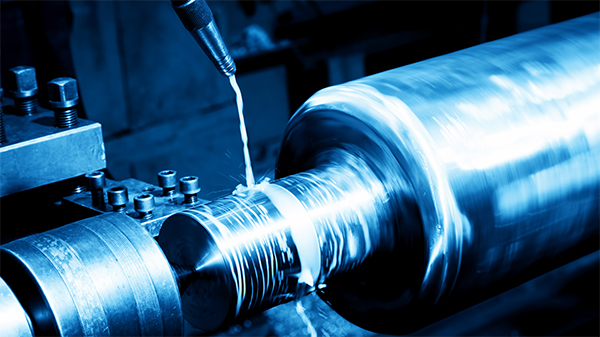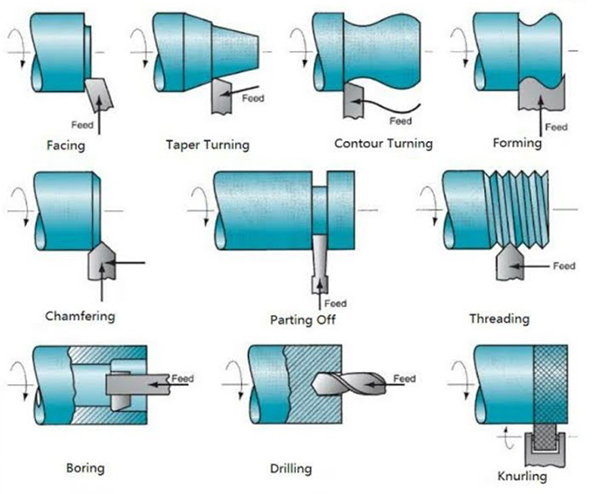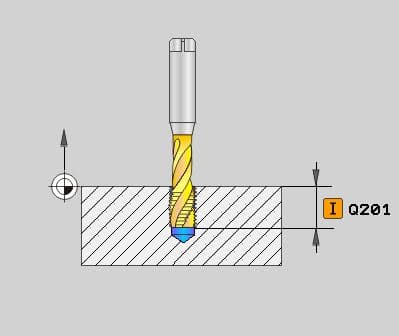CNC machining has evolved the manufacturing industry with highly accurate and precise operations. Manual machining centers were a big breakthrough for the manufacturing industry in the old days. However, computer-controlled programs and their applications in the manufacturing industry have made things even more convenient and flexible for the industries.
Milling, drilling, boring, turning, and a lot of other manufacturing processes can be precisely done with the CNC machining centers that employ pre-programmed controls. The CNC turning process and milling process are popular as well as opposite to each other.

The main difference between the two processes is that the milling centers rotate the tools around the workpiece to complete the fed operations. On the other hand, the turning centers do not move the tool. Instead, the workpiece is rotated to get the desired operations.
CNC turning machines are capable of running a variety of operations during a manufacturing process. Therefore, they are regarded as all-in-one CNC machining centers. However, in today’s article, we will be talking about the tapping program in the CNC turning machines. We will walk you through understanding the tapping cycle for the turning machines, designing a program, and the benefits of using the tapping program on turning machines.
So let’s get into it.
A CNC turning machine is a computer numerically controlled manufacturing machine with 3,4 or sometimes five axes. The machining centers have capabilities to perform different cutting operations ranging from turning, drilling, milling, or tapping.
If we define the turning process in CNC machining, it’s the manufacturing process in which the cutting tool installed on the spindle is moved linearly instead of rotations. In contrast, the workpiece is rotated at high speed to get the desired results.
There are two types of turning machine centers: vertical turning centers and horizontal turning centers. Each type of turning center has its own benefits and downsides. Vertical machining centers have the spindle axis oriented vertically, and the cutters are held in the spindle to rotate on the axis. In contrast, the horizontal centers are usually used for flat surfaces.

Before we move on to the tapping program in CNC turning centers, let’s have a basic overview of the operations commonly performed by the turning centers. Here is the list of operations the CNC turning centers are capable of:
1. Turning
2. Facing
3. Drilling
4. Threading
5. Boring
6. Knurling
7. Grooving

The answer to this question is yes! You can tap the pre-drilled holes on the turning centers. The CNC tapping on turning machines is usually done for the cylindrical or round workpieces. The tapping cycle on the turning machines can be designed using rigid tapping cycles.
The rigid tapping cycle can be programmed on machines specifically capable of operations. The problem of lack of synchronization can be eliminated by using the tapping cycle on the turning machines. The machines not supporting rigid tapping will need a separate tap holder to perform the tapping.
The tapping program on turning machines is also similar to the normal tapping program that requires varying taps depending on the type and depth of the hole needed in the manufacturing process. Tapping is the process of creating threads inside the drilled holes in the CNC machining centers.
Like most CNC machining centers, G84 is the function commonly used for tapping operations. As mentioned, rigid tapping is used in turning machines to cut the internal threads of pre-drilled holes. The main difference between general tapping and rigid tapping is that the tap is locked in the spindle in the rigid tapping. On the other hand, the tapping head has freedom along the spindle axis in the case of standard tapping.
The benefit of using the rigid tapping function is that you can increase the life of your taps, get better part quality as well a shorter machining time. Therefore, the technique is useful for tapping the blind holes where tap depth controlling is an important concern.
We will also walk you through the process of tapping in CNC turning centers and guide you on creating programs to run the rigid tapping operations. Let’s head to the next section and discover how G84 is employed to program the tapping in turning centers.
The G84 tapping cycle is commonly used in rigid tapping, which doesn’t require a tapping head. Instead, the tap is held by the standard tool holder. The same cycle can be employed when peck tapping is required in cases with higher hole depth. In such cases, the canned cycle is repeated again and again until full thread depth is achieved.
Let’s walk through each type of tapping cycle with G84.
Let’s begin with the rigid tapping cycle’s basics. The Gcode for the rigid tapping cycle will be G84. G84 tapping implies that such tapping operation will be carried along the x-axis. In other words, the operation will run on the z-axis.
The rigid tapping cycle program will be entered on the turning machine as follows:

G84 Z R Q F
In some cases, you can also add P to the function, and it will be written as:
G84 Z Q P R F
What do these alphabets represent in the tapping program along the z-axis in turning centers?
G84 = G-Code to represent the tapping cycle where clockwise rotations are made
• Z refers to the depth of the hole that has to be threaded in the tapping operation.
• Q refers to the peck distance which is written in micrometers(μm). The peck distance is a relevant measure when you want to drill long holes, and it won’t be possible with one tapping cycle. We will further talk about the peck-tapping cycle in the next section.
• R refers to the retract value in the program. It implies the distance from the initial point where a peck should end. In general G-codes, R refers to the radius of the workpiece. However, in the case of the G84 tapping cycle, it means the retract distance from the datum after each thread is tapped.
• P is not always used, but when used, it refers to the dwell time at the button of the hole. You can add the dwell time in milliseconds to stop the machine after each thread for removing chips from drilled holes.
• F is the value of pitch size. For instance, in the case of M 10 x 1.5, the value of f will be 1.5
After defining the values, let’s talk a bit about the threading process. You must add the z value to represent the thread depth.
Besides, the retract value is also necessary when making the program; otherwise, the machine will return to the last depth defined within the program. Do not skip the R-value also because adding the value will increase the speed of tapping operations by returning to a position closer to the material’s surface and not to a safe, rapid distance.
If we talk about the peck tapping cycle, it’s appropriately useful when you want to thread long holes on turning machine centers. You don’t need to use the peck value for the shallow holes; it can be completed without repeating the cycles.
The Peck tapping cycle is beneficial for long holes because it contributes to the tap life and avoids tap breakage. For instance, if you’re tapping a hole of 30mm, you can make three pecks of 10mm each or 6 pecks of 5mm each.
For the peck-tapping cycle, the peck tap has to be used. The tap will thread the holes in stages. The Q value defines the distance of the thread that will be tapped before the spindle is reversed and goes back to the R position.
Now let’s make an example tapping program to run on a turning machine.
Let’s suppose the depth of the hole is 30 mm.
The tap size value is M 10 x 1.5, which means that the basic diameter is 10mm, the pitch size is 1.5mm, and the drill size will be 8.5mm. Let’s suppose we want to make three pecks of 10mm each. The tapping program for the turning center will be as follow:
G84 (X) (Y) Z R (Q) F
X and Y will represent the hole coordinates, which is an optional value.
However, if we have to give a full example of the Tapping program on the turning machine, here is what it will look like:
00002
N1
G28 U0.0 W0.0
G97 S100 M4
M08
T0101
GO X 0.0 Z 2.0
G84 Z30.0 R1.0 Q10000 F1.5
G28 U0.0 W0.0
M09;
M05;
M30;
The complete program on the turning machine implies that the value of S will be 100. It should remain between 100-300 for tapping purposes. Otherwise, the implications might come to you.
M4 represents the reference point of the tapping tool. It is the tapping position when threads are being made. When a tap completes the threading, it goes back to M3.
F represents the feed rate which is equal to the pitch rate.
G28 is when the spindle goes back to its zero position via a reference point.
M09 implies the coolant is turned off, M05 states the spindle is stopped, and M30 implies the program is ended.

CNC tapping, whether done on a turning machine, milling machine, or any other CNC machine, offers several benefits, including cost-effectiveness, a simple process, and higher precision. However, the specific benefits of using a turning machine center for tapping purposes are as follows:
The rigid tapping is way faster than the thread milling. The rapid tapping cycles make it an effective process for threading. The speed of rigid tapping is so high that it can thread a hole in a fraction of the time that thread milling will take for the same size of hole.
The taps are not moved in the turning process, and the workpiece or part is rotated to thread the holes. You can also peck the narrow holes to avoid tap breakage in the case of rigid tapping with turning centers.
Rigid tapping is best done on the blind holes, as the threading length is a concern for the milling machines. You can easily control the length of threading holes and also get high precision with peck tapping.
There are certain downsides to tapping on the CNC turning center as well. The most common are as follows.
When you want to tap threads in the blind holes, the biggest challenge is the chip breaking due to chip overload. Removal of chips is one of the main concerns not addressed as seriously in the turning center. However, you can add the value of P, representing the dwell time, but in milling centers, better chip control is offered, making it easier to machine holes without any hindrances. It is the time you can add to the program to remove the chips between the tapping cycles.
Turning machine center tapping will require specialized taps for varying hole types. It can affect the cost-effectiveness of the method.
We have shared everything you need to know about the tapping program run in the CNC turning machines. We have also walked you through the complete program of a tapping cycle and how the program for a CNC turning machine will look. However, you should carefully evaluate all the factors when choosing the machine for any operation. We hope this information will help you to leverage your turning machine center for threading holes of different types.